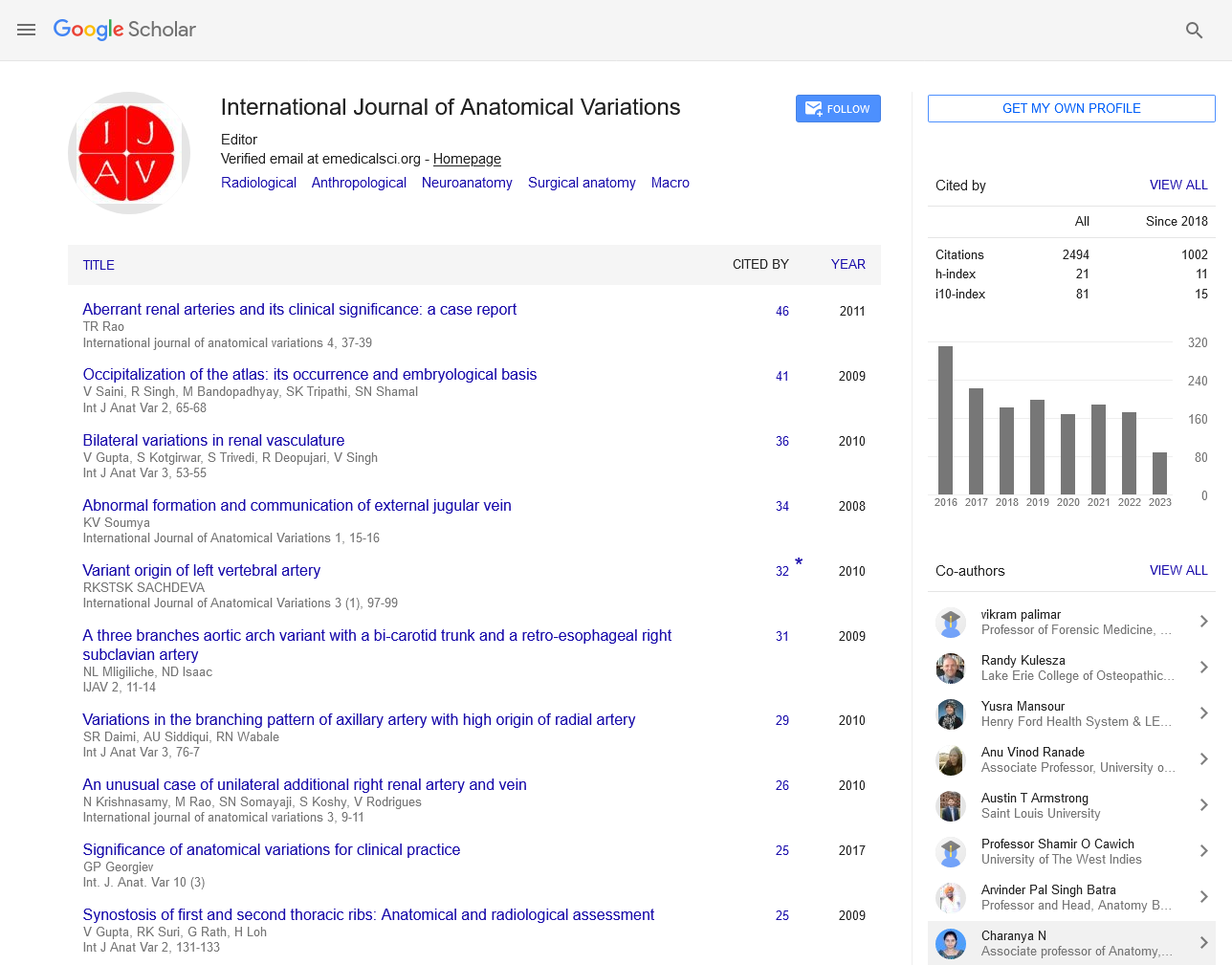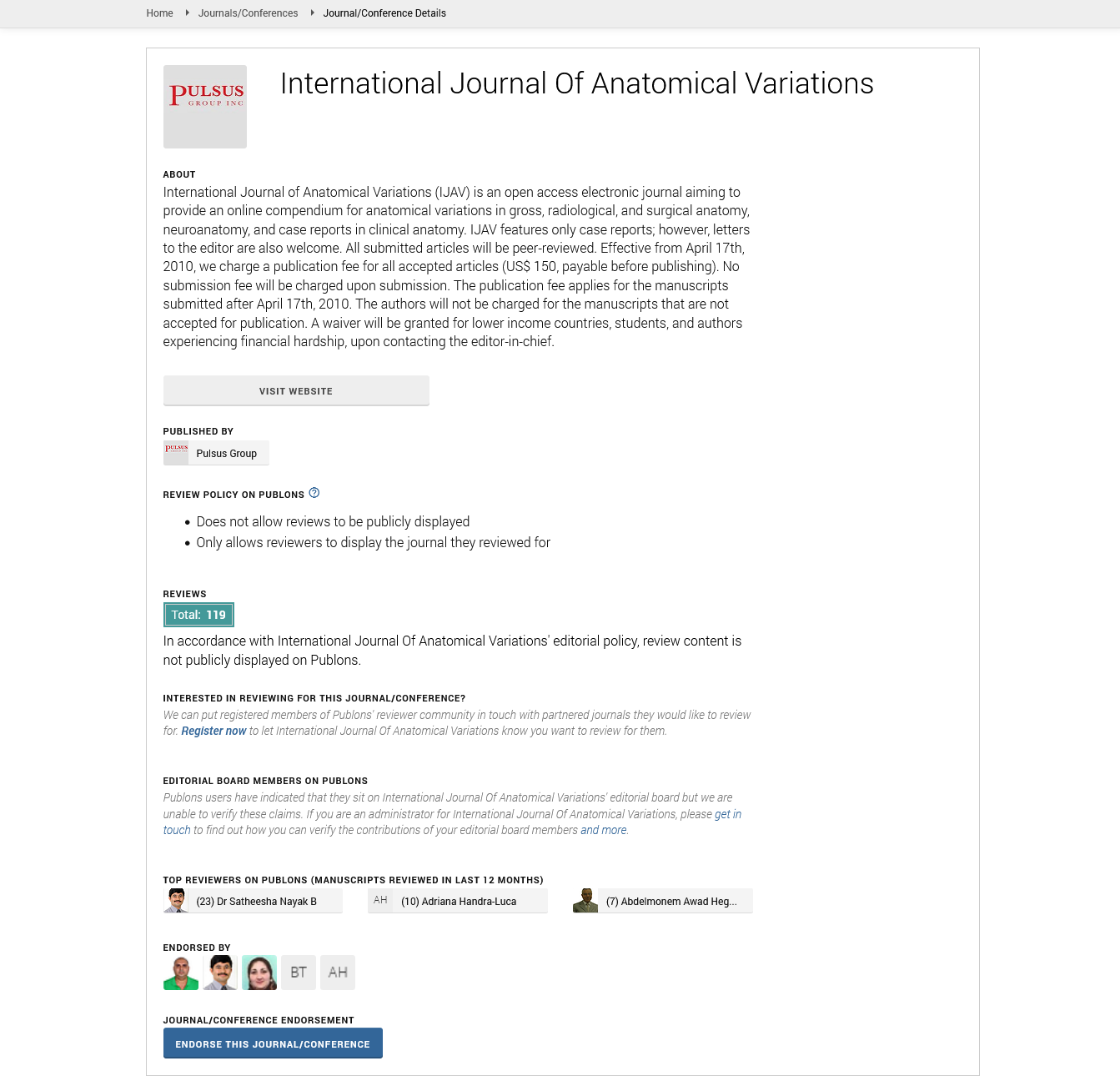Developmental Anatomy Variations Exploring Patterns Causes and Clinical Relevance
Received: 01-Jun-2024, Manuscript No. ijav-24-7094; Editor assigned: 05-Jun-2024, Pre QC No. ijav-24-7094 (PQ); Reviewed: 21-Jun-2024 QC No. ijav-24-7094; Revised: 27-Jun-2024, Manuscript No. ijav-24-7094 (R); Published: 29-Jun-2024, DOI: 10.37532/1308-4038.17(6).406
Citation: Amanita Reddy. Developmental Anatomy Variations Exploring Patterns Causes and Clinical Relevance. Int J Anat Var. 2024;17(6): 597-598.
This open-access article is distributed under the terms of the Creative Commons Attribution Non-Commercial License (CC BY-NC) (http://creativecommons.org/licenses/by-nc/4.0/), which permits reuse, distribution and reproduction of the article, provided that the original work is properly cited and the reuse is restricted to noncommercial purposes. For commercial reuse, contact reprints@pulsus.com
Abstract
Developmental anatomy variations refer to deviations in anatomical structures that arise during embryonic and fetal development. These variations can affect any part of the human body and result from genetic, environmental, and stochastic factors influencing morphogenesis. This article reviews the classification, etiology, clinical implications, and management of developmental anatomy variations, highlighting their importance in medical diagnostics, surgical interventions, and evolutionary biology.
Keywords
Developmental Anatomy Variations; Congenital Anomalies; Morphological Diversity; Clinical Implications; Genetic Factors; Environmental Influences.
INTRODUCTION
Developmental anatomy variations encompass a wide spectrum of structural deviations that occur during the intricate process of embryonic and fetal development [1]. These variations, ranging from minor anomalies to complex malformations, play a crucial role in shaping individual anatomical diversity and pose significant challenges and opportunities in medical practice and research. Understanding the etiology of developmental anatomy variations is fundamental to unraveling their complexity. Genetic mutations, chromosomal abnormalities, and environmental influences during critical periods of development can disrupt normal morphogenesis [2], leading to structural anomalies. The study of these variations not only informs our understanding of embryonic development but also sheds light on the interplay between genetic predisposition and environmental exposures in shaping human anatomy.
CLASSIFICATION OF DEVELOPMENTAL ANATOMY VARIATIONS
Developmental anatomy variations can be classified based on their anatomical location, developmental timing, and underlying etiological factors:
- Major vs. Minor Anomalies: Distinguishing between anomalies that significantly impact function or appearance versus those that are relatively benign [3].
- Congenital vs. Acquired Variations: Differentiating anomalies present at birth from those that develop later due to environmental influences or genetic changes [4].
- Embryological Basis: Classifying variations according to their developmental origins, such as defects in organogenesis, morphogenesis, or tissue differentiation [5].
ETIOLOGY OF DEVELOPMENTAL ANATOMY VARIATIONS
The etiology of developmental anatomy variations is multifactorial, involving genetic, environmental, and stochastic influences. Genetic factors, including inherited mutations and chromosomal abnormalities [6], can disrupt normal developmental pathways, leading to structural anomalies. Environmental influences, such as maternal nutrition, exposure to toxins, and infections during pregnancy, also play significant roles in shaping developmental outcomes. Additionally, stochastic events and random mutations can contribute to sporadic anomalies that arise without apparent genetic or environmental predispositions.
CLINICAL IMPLICATIONS AND MANAGEMENT STRATEGIES
Developmental anatomy variations have profound implications for clinical practice, affecting diagnosis, treatment planning, and patient outcomes. These variations may present challenges in medical imaging, surgical procedures, and therapeutic interventions, requiring tailored approaches to address anatomical complexities [7]. Advances in imaging technologies, such as MRI and 3D ultrasound, have improved our ability to detect and characterize developmental anomalies prenatally and postnatally, facilitating early intervention and management. Management strategies for developmental anatomy variations often involve multidisciplinary collaboration, with healthcare professionals from various specialties working together to optimize patient care. Conservative management, surgical correction, and supportive therapies are tailored to the specific anatomical and functional implications of each variation, aiming to improve quality of life and long-term outcomes for affected individuals [8].
EVOLUTIONARY PERSPECTIVES
From an evolutionary standpoint, developmental anatomy variations offer insights into the adaptive significance of anatomical diversity within and across populations [9]. Variations that confer reproductive advantages or survival benefits in specific environments may be subject to natural selection, influencing the prevalence of certain traits over time. Studying these variations in a comparative anatomical context can enhance our understanding of human evolution and the mechanisms driving species diversification [10].
CONCLUSION
Developmental anatomy variations represent a complex interplay of genetic, environmental, and stochastic factors that shape human morphological diversity. By investigating the patterns, causes, and clinical implications of these variations, we deepen our understanding of embryonic development, improve medical diagnostics and treatment strategies, and gain insights into evolutionary processes. Continued research into developmental anatomy variations holds promise for advancing personalized medicine, enhancing prenatal care, and furthering our knowledge of human biology and evolution.
REFERENCES
- Pires LAS, Souza CFC, Teixeira AR, Leite TFO, Babinski MA, et al. Accessory subscapularis muscle–A forgotten variation?. Morphologie. 2017; 101(333):101-104.
- John C, Christian J. Commentary: Thoracic surgery residency: Not a spectator sport. J Thorac Cardiovasc Surg. 2020 Jun; 159(6):2345-2346.
- Anri S, Masayoshi O, Shigeru H. Glomerular Neovascularization in Nondiabetic Renal Allograft Is Associated with Calcineurin Inhibitor Toxicity. Nephron. 2020; 144 Suppl 1:37-42.
- Mamikonyan VR, Pivin EA, Krakhmaleva DA. Mechanisms of corneal neovascularization and modern options for its suppression. Vestn Oftalmo. 2016; 132(4):81-87.
- Gaigalaite V, Dementaviciene J, Vilimas A, Kalibatiene D. Association between the posterior part of the circle of Willis and vertebral artery hypoplasia. PLoS ONE. 2019; 14(9): e0213-226.
- Mujagic S, Kozic D, Huseinagic H, Smajlovic D. Symmetry, asymmetry and hypoplasia of intracranial internal carotid artery on magnetic resonance angiography. Acta Med Acad. 2016; 45:1- 9.
- Rusu MC, Vrapclu AD, Lazar M. A rare variant of accessory cerebral artery. Surg Radiol Anat. 2023; 45(5):523-526.
- Krause DA, Youdas JW. Bilateral presence of a variant subscapularis muscle. Int J Anat Var. 2017; 10(4):79-80.
- Mann MR, Plutecki D, Janda P, Pękala J, Malinowski K, et al. The subscapularis muscle‐a meta‐analysis of its variations, prevalence, and anatomy. Clin Anat. 2023; 36(3):527-541.
- Pillay M, Jacob SM. Bilateral presence of axillary arch muscle passing through the posterior cord of the brachial plexus. Int. J. Morphol., 27(4):1047-1050, 2009.
Indexed at, Google Scholar, Crossref
Indexed at, Google Scholar, Crossref
Indexed at, Google Scholar, Crossref
Indexed at, Google Scholar, Crossref
Indexed at, Google Scholar, Crossref
Indexed at, Google Scholar, Crossref
Indexed at, Google Scholar, Crossref
Indexed at, Google Scholar, Crossref






